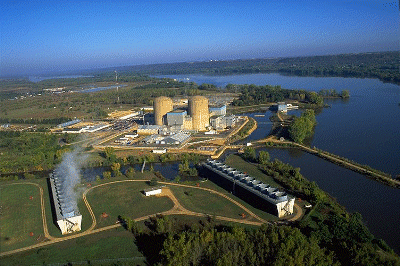|
|
 |
Prairie Island Nuclear Power Plant - Minnesota
The Prairie Island Nuclear Power Plant is located on the Mississippi River near Red Wing, approximately 50 miles southeast of the Minneapolis-St. Paul metropolitan area. The facility, owned/operated by Northern States Power (NSP), has 2 units, each with a 2 Loop Westinghouse Pressurized Water Reactor. Each unit generates between 545 and 575 MWe, depending on time of year (depending on river water temperature and whether the cooling towers, described below, are operating). The Prairie Island units are operated as base-loaded (i.e. steady state of 100%). Together the 2 units generate about 20% of NSP's electrical energy demand requirements (equivalent to half of the residential demand of the system).
|
|
 |
A number of simplified diagrams illustrate the the design of this pressurized water reactor plant (courtesy Westinghouse) on the PWR Cycle page.
In the foreground of the photo on the right above are the Cooling Towers. Some power plants, usually located on lakes or rivers, use cooling towers as a method of cooling the circulating water (the third non-radioactive cycle) that has been heated in the condenser. During colder months and fish non-spawning periods, the discharge from the condenser may be directed to the river. Recirculation of the water back to the inlet to the condenser occurs during certain fish sensitive times of the year (e.g. spring, summer, fall) so that only a limited amount of water from the plant condenser may be discharged to the lake or river. During these times, the maximum temperature difference between the river water discharged to the river and the water upstream of the plant is restricted to 5 degrees Fahrenheit.
Mechanical draft Cooling Towers, as in the Prairie Island case, have long piping runs that spray the water downward. Large fans pull air across the dropping water to remove the heat. As the water drops downward onto the "fill" or slats in the cooling tower, the drops break up into a finer spray. On colder days, tall plumes of condensation can be seen. On warmer days, only small condensation plumes will be seen.
The NRC maintains a Plant Technical Book for the Prairie Island Unit 1 and Unit 2 with more detailed system descriptions and drawings.
Copyright © 1996-2004. Joseph Gonyeau, P.E.. The Virtual Nuclear Tourist. All rights reserved. Revised: March 15, 2001.